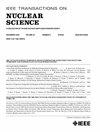RPP Model Trends Across Technology Nodes for the MC Simulation of SEUs in Commercial Bulk Planar CMOS SRAMs Under Proton Irradiation
IF 1.9
3区 工程技术
Q3 ENGINEERING, ELECTRICAL & ELECTRONIC
引用次数: 0
Abstract
The ubiquitous use of electronic devices in high-radiation environments requires robust methods for assessing and improving their resilience against single-event effects (SEEs) and, especially, single-event upsets (SEUs). In this study, SEU production induced by protons below 500 MeV in three commercial bulk planar static random access memories (SRAMs) manufactured on different standard CMOS technology nodes (from 250 to 40 nm) is investigated employing the Monte Carlo (MC) particle-transport code FLUKA. A rectangular parallelepiped (RPP) model is adopted to describe the device geometry, relying on the sensitive volume (SV) and the critical charge as effective parameters. Optimal values of these two parameters that maximize the agreement between simulated and experimental SEU production cross sections are found for the three considered devices. Parameter trends in the RPP model across technology nodes are identified, thus providing practical guidelines when modeling components manufactured on other technology nodes.求助全文
约1分钟内获得全文
求助全文
来源期刊

IEEE Transactions on Nuclear Science
工程技术-工程:电子与电气
CiteScore
3.70
自引率
27.80%
发文量
314
审稿时长
6.2 months
期刊介绍:
The IEEE Transactions on Nuclear Science is a publication of the IEEE Nuclear and Plasma Sciences Society. It is viewed as the primary source of technical information in many of the areas it covers. As judged by JCR impact factor, TNS consistently ranks in the top five journals in the category of Nuclear Science & Technology. It has one of the higher immediacy indices, indicating that the information it publishes is viewed as timely, and has a relatively long citation half-life, indicating that the published information also is viewed as valuable for a number of years.
The IEEE Transactions on Nuclear Science is published bimonthly. Its scope includes all aspects of the theory and application of nuclear science and engineering. It focuses on instrumentation for the detection and measurement of ionizing radiation; particle accelerators and their controls; nuclear medicine and its application; effects of radiation on materials, components, and systems; reactor instrumentation and controls; and measurement of radiation in space.
 求助内容:
求助内容: 应助结果提醒方式:
应助结果提醒方式:


